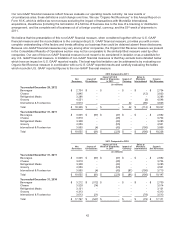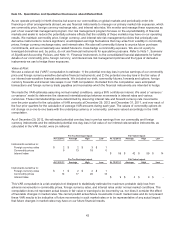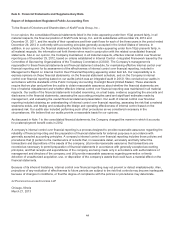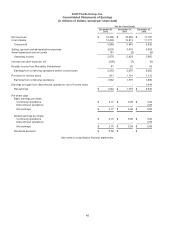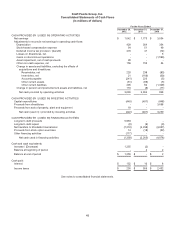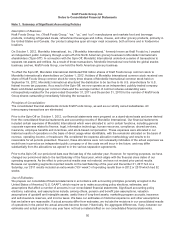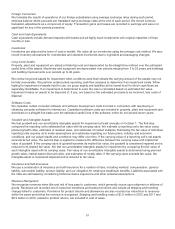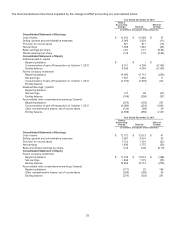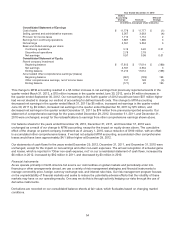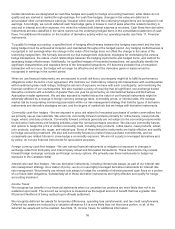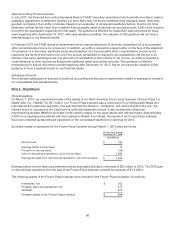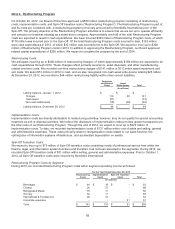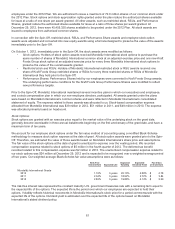Kraft 2012 Annual Report Download - page 54
Download and view the complete annual report
Please find page 54 of the 2012 Kraft annual report below. You can navigate through the pages in the report by either clicking on the pages listed below, or by using the keyword search tool below to find specific information within the annual report.Marketing and Research and Development:
We promote our products with consumer incentives, trade promotions, and advertising. These programs include, but are
not limited to, discounts, coupons, rebates, in-store display incentives, and volume-based incentives. Consumer incentive
and trade promotion activities are recorded as a reduction to revenues based on amounts estimated as being due to
customers and consumers at the end of a period. We base these estimates principally on historical utilization and
redemption rates. For interim reporting purposes, advertising and consumer incentive expenses are charged to operations
as a percentage of volume, based on estimated volume and related expense for the full year. We do not defer costs on our
year-end consolidated balance sheet and all marketing costs are recorded as an expense in the year incurred. Advertising
expense was $640 million in 2012, $535 million in 2011, and $540 million in 2010. We expense costs as incurred for
product research and development. Research and development expense was $178 million in 2012, $198 million in 2011,
and $185 million in 2010. We record marketing expense in selling, general and administrative expense, except for
consumer incentives and trade promotions, which are recorded in net revenues. Research and development expenses are
recorded within selling, general and administrative expenses.
Environmental Costs:
We are subject to laws and regulations relating to the protection of the environment. We accrue for environmental
remediation obligations on an undiscounted basis when amounts are probable and can be reasonably estimated. The
accruals are adjusted as new information develops or circumstances change. Recoveries of environmental remediation
costs from third parties are recorded as assets when recovery of those costs is deemed probable. At December 29, 2012,
our subsidiaries were involved in 63 active actions in the U.S. under Superfund legislation (and other similar actions and
legislation) related to current operations and certain former or divested operations for which we retain liability. We are
subject to applicable multi-national, national, and local environmental laws and regulations in the countries in which we do
business. We have specific programs across our business units designed to meet applicable environmental compliance
requirements.
As of December 29, 2012, we had accrued an amount we deemed appropriate for environmental remediation. The amount
was insignificant to our balance sheet. Based on information currently available, we believe that the ultimate resolution of
existing environmental remediation actions and our compliance in general with environmental laws and regulations will not
have a material effect on our financial condition. However, we cannot quantify with certainty the potential impact of future
compliance efforts and environmental remediation actions.
Postemployment Benefit Plans:
We provide a range of benefits to our eligible employees and retired employees. These include defined benefit pension,
postretirement health care, defined contribution, and multiemployer pension and medical benefits. Our pension,
postretirement, and other postemployment (collectively, “postemployment”) benefit plans cover most salaried and certain
hourly employees. The cost of these plans is charged to expense over the working life of the covered employees. Prior to
the Spin-Off, Mondele¯ z International provided certain of these benefits to our employees and allocated to us the related
costs. The liabilities associated with the Mondele¯z International plans were not reflected in our balance sheets as we
accounted for our participation in the Mondele¯z International plans in a manner similar to multiemployer accounting.
In December of 2012, we elected to change our method of accounting for defined benefit costs. Under our new accounting
method, we recognize net actuarial gains or losses and changes in the fair value of plan assets immediately upon
remeasurement, which is at least annually, and typically in the fourth quarter of each year. Previously, we calculated the
market-related value of plan assets reflecting changes in the fair value of plan assets over a four-year period. In addition,
actuarial gains or losses were deferred, and amounts in excess of 10 percent of the greater of the market-related value of
plan assets or the plans’ projected benefit obligation were recognized over the remaining service life of plan participants.
We believe that this new mark-to-market (“MTM”) policy is preferable as it will provide greater transparency to on-going
operational results and better reflect the economics of our obligations to participants. This change has been reported
through retrospective application of the new policy to all periods presented.
On October 1, 2012, Mondele¯ z International transferred $3.8 billion of accumulated other comprehensive losses to us
related to our postemployment benefit plans. As part of the retrospective application of our new MTM policy, $4.1 billion,
representing all the unrecognized actuarial losses at October 1, 2012, were reclassified to additional paid-in capital as part
of the initial equity capitalization upon the consummation of our Spin-Off.
52


